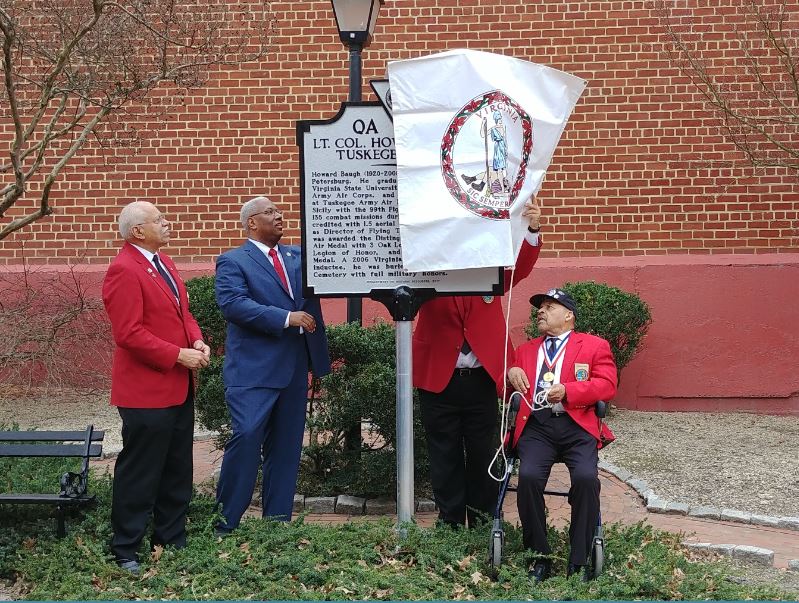
The unveiling of the Lt. Col. Howard Baugh, Tuskegee Airman marker in Petersburg.
The Board of Historic Resources recently adopted new procedures for approving marker applications from the public. The next deadline for submitting applications is February 1, 2026.
Marker Application 2026 [docx] | Marker Application 2026 [PDF]
Each year individuals, historical societies, civic groups, businesses, and local governments sponsor the creation of new historical highway markers. Since 1976, the Commonwealth of Virginia has required that a sponsor pay for the manufacture of an approved highway marker. Today that cost is about $3,000, as determined by the Ohio-based foundry (Sewah Studios) that manufactures the markers. In some jurisdictions, the sponsor also may be responsible for payment of expenses associated with installation of the sign.
The first step in proposing a new marker, however, costs nothing. It simply requires that a sponsor submit an application to DHR.
If you have an idea for a potential marker highlighting an historical person, place, event, or institution in Virginia, be sure that the topic meets the first criterion: It must have significance beyond the local level and extend, at the very least, to a regional level within the state (e.g. the Shenandoah Valley, Northern Virginia, Tidewater, etc.). For additional guidance and information about topic eligibility, see the marker application form, which provides detailed instructions.
Marker Program staff will select the five highest-scoring marker proposals from the pool received at each deadline. Staff will then present this list of selected topics to the BHR for approval at its next meeting, approximately seven weeks after the application deadline. At the subsequent meeting of the BHR, three months later, staff will present the final texts of those five markers for official Board approval.
Any applicant whose project is not one of the five selected will be eligible to apply again in the future, but applications will not automatically be carried over to future board cycles.
The four deadlines for submitting applications are as follows:
February 1: The BHR will approve the selection of five markers from this pool of applicants at its March meeting; the BHR will consider the texts of these markers at its June meeting.
May 1: The BHR will approve the selection of five markers from this pool of applicants at its June meeting; the BHR will consider the texts of these markers at its September meeting.
August 1: The BHR will approve the selection of five markers from this pool of applicants at its September meeting; the BHR will consider the texts of these markers at its December meeting.
October 20: The BHR will approve the selection of five markers from this pool of applicants at its December meeting; the BHR will consider the texts of these markers at its March meeting.
Proposed marker topics will be evaluated based on the following criteria:
25 points Has potential to educate the public
25 points Fills a gap in the historical marker program in order to address a topic that the program has not extensively covered
20 points Addresses the history of a community that has been marginalized or underrepresented
20 points Reflects a breadth of historical significance that extends beyond the locality, preferably demonstrating statewide or national significance
10 points Contributes to a more equitable geographic distribution of markers
If your application is selected as one of the five that will move forward toward official approval, DHR staff will work with you to finalize the text that will appear on the marker. Staff will conduct additional research if necessary and will edit the text for accuracy, clarity, brevity, thoroughness, and educational value. The goal during this process is to write a concise, polished, and well-documented marker. Staff will then send the text to the Marker Editorial Committee, a group of outside scholars. If the committee accepts the text, DHR staff will present it to the Board of Historic Resources for official approval.
Once a marker is approved by the board, a district representative from the Virginia Department of Transportation (or a local public works department, if the marker is to be placed in an independent town or city outside of VDOT’s authority) will meet with the sponsor to determine a suitable roadside site for placing the marker in the public right-of-way.
For a more detailed description of the marker application process, refer to the marker application form above.
If you have any questions about the application process after reviewing the marker criteria and procedures, please contact Jennifer R. Loux at (804) 482-6089.
Updated February 2, 2023On the page about highway marker applications, please change “The next deadline for submitting applications is October 20, 2025” to “The next deadline for submitting applications is February 1, 2026.” Thanks!